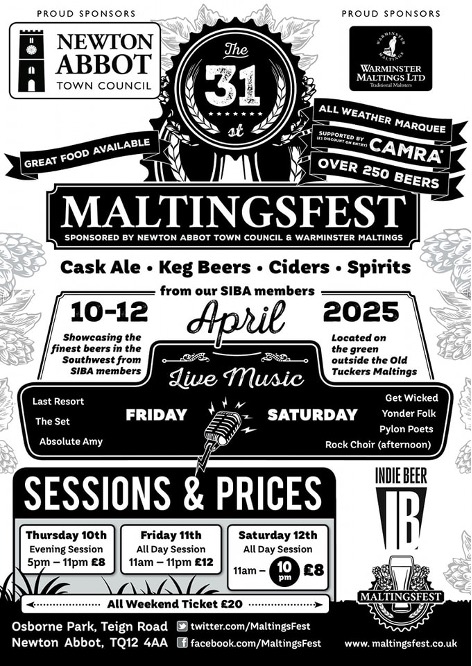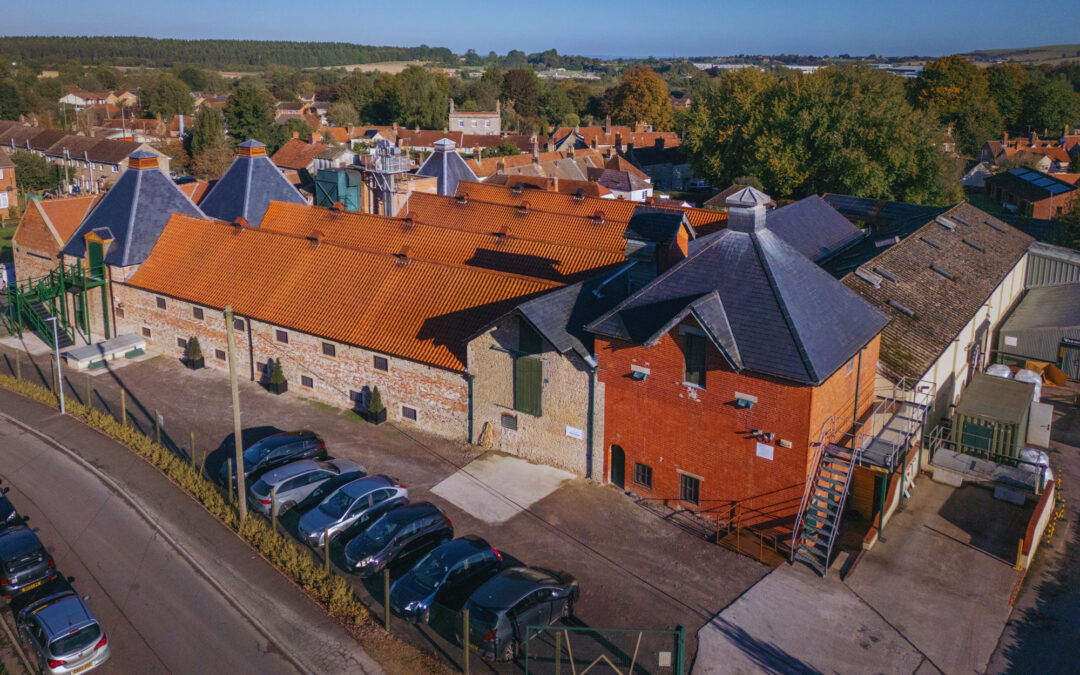
Edition 57: Friends of Warminster Maltings

Press release
In mid-February we issued a new pamphlet showing off our maltings, photographed from the air by a drone mounted camera. This was both transmitted electronically and sent out as hard copies. We are attempting to address a very wide audience, drawing their attention to the completion of 24 years of very hard and highly skilled work, both repairing and restoring our malthouses.
All this work has been carried out to not only enhance the resilience of the fabric of the buildings, but to also incorporate, where necessary, modern infrastructure for making malt in the 21st century. However, throughout, the priority has always been to protect the integrity of the external architecture of our Grade 2* Listed malthouses. Today, they should look almost the same as the complex that William Morgan built back in 1855, with x3 (out of x4) of its original pyramid style kiln roofs dominating the western elevation.
So, after 24 years, you will not be surprised we want to celebrate this achievement, which we will probably do all year. Already, we are finalising the highlight, which will be a formal ‘unveiling ceremony’, on Wednesday evening, June 11th. This will be performed by Miles Jenner, MD of Harveys Brewery in Lewes, and President of the Brewery History Society. This evening party will include mini-tours of the malt floors, a chance to view our new museum, and, “for one night only” our attempt to portray the Warminster Maltings Story, our very own performance, in words and music, by a whole swathe of local artistes and musicians. A hog-roast will be served all evening, and, of course, there will be an extensive choice of beers.
This has to be an “Invitation Only” event (we are not selling tickets), first of all targeted at our customers, also our suppliers, and all those who have helped us along the way. Initially, invitations have to be limited on account of our limited space. They will go out in April, and if you receive one, and you would like to attend, you are asked to ‘RSVP’, and we recommend you reply sooner rather than later.

If you do not receive one, but you would like to come, you can apply to the office for an invitation, Email: lisa.conduit@warminster-malt.co.uk and we will try and accommodate you. We apologise we have to word it this way, because, at this stage, we have no idea of how many on our invitation list will respond. But we do have a very good idea of just how many people we can fit in.
June 11th is not just “any excuse for a party”, but very much all about maintaining a high profile for our business. The brewing industry currently faces serious headwinds, and even the distilling industry is not selling as much whisky today as it was 2 or 3 years ago. So there is absolutely no room for any complacency at Warminster Maltings – we have to be continually transmitting our message, and finding new ways to do it. After all, we always need new enquiries, it is key to ensuring we remain constantly busy.
A View on the Future

On the subject of ‘new enquiries’, we hope we will continue to attract them. According to Jeffrey M Pilcher, Professor of History and Food Studies at the University of Toronto, in his new book “Hopped Up”, the future of Craft Brewing “depends on maintaining a moral high ground through associations with desirable qualities such as local, artisanal, communal, sustainable and nostalgic beers”!
At Warminster Maltings, we would like to think we do provide some of this. And, we are always more than happy to share our contribution with our customers, in whatever form they request. In the last few weeks, we have entertained two separate customers with their film crews, compiling footage for websites and social media platforms. We are open to doing more. As my father used to say to me, when I was young:
He who whispers down a well,
of the goods he has to sell;
never makes as many dollars,
as he who climbs a tree, and hollas!
Vive La France!
A headline which caught my eye since the last newsletter: “French drinking more beer than wine!”
According to this report, between the years 2019 and 2023, beer consumption exceeded wine by 5%. It seems they are now knocking back 26 litres/household/annum, up from 24 litres.
There was no real analysis offered, but in a country where there are far less Craft Breweries per capita compared to the UK – at the most no more than a third – this is perhaps a remarkable turnaround. At Warminster we do not have any further insight on this, we lost most of our French customers on the back of Brexit. But a simple explanation could be that the French attitude to beer is not dissimilar to their attitude to food. They take pride in only producing the best. After all, they do have a long history of making beer. Archeologists have discovered the remains of Roman Breweries in Brittany, so wine making and brewing have almost certainly grown up side-by-side. That the more discerning palate of the French is shifting in favour of beer, is most encouraging.

MaltingsFest 2025!
Thursday 10th – Saturday 12th April

Next month marks the 31st annual MaltingsFest, held once again at Osborne Park, Newton Abbot, Devon – a celebration of the fantastic beers crafted across the South West.
It’s a brilliant opportunity for brewers, including many of our valued Warminster Maltings customers, to showcase their brews, and perhaps even take home an award or two!
Unfortunately, we’re unable to attend this year and have taken a step back from our usual role as lead sponsors (due to our own exciting celebrations on the horizon), but we highly recommend getting along to it if you can.
Whether you join for one session or soak up the atmosphere across the whole festival, we’re sure you’ll be in for a treat—great beers, great company, and a fantastic experience!













